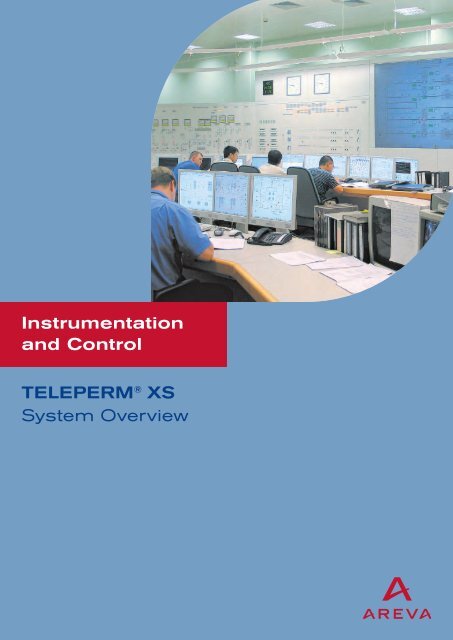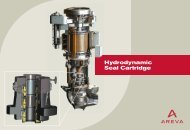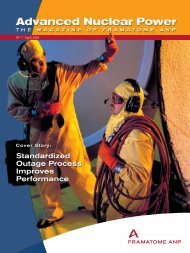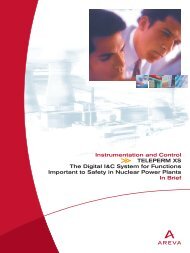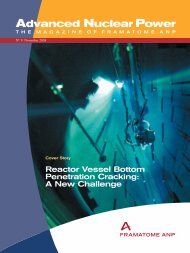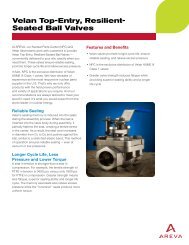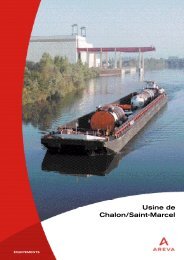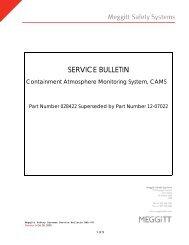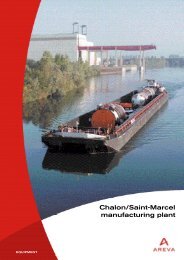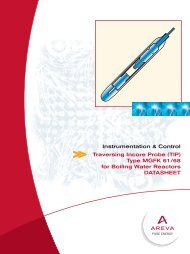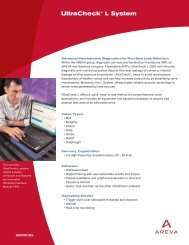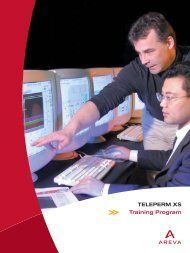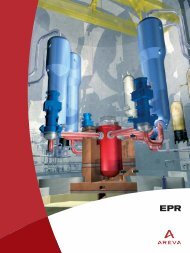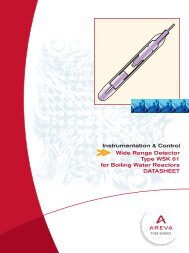TELEPERM® XS System Overview - AREVA NP Inc.
TELEPERM® XS System Overview - AREVA NP Inc.
TELEPERM® XS System Overview - AREVA NP Inc.
You also want an ePaper? Increase the reach of your titles
YUMPU automatically turns print PDFs into web optimized ePapers that Google loves.
Qualification 30 Qualification Concept 30 Hardware qualification 31 Software qualification 32 Plant-independent integration and system test 33 Two-stage licensing 34 Keeping system qualification up-to-date in the long term 35Operation 36 Virtually no maintenance 36 Extended test intervalls 37 Troubleshooting 38 The service unit 39 User interfaces of the service unit 40 The diagnostics interface 41Long-term support for TELEPERM ® <strong>XS</strong> 42 Long-sighted replacement strategy for components 42 Configuration management and change procedure 44 Support and information 45Hard- and Software 46 Computer and communication components 46 Input/output modules 46 Signal conditioning 47 Neutron flux instrumentation modules 47 Signal logic, isolation and output modules 48 Subracks, packaging system, test equipment 49 Software packages 49<strong>System</strong> data 50 Supply voltage 50 Climate 50 Seismic certifications 50 Grounding and shielding 50 Performance data 50 Standard cabinet SC 9422 50 Wall-mounted enclosure SWE 12 503
<strong>Overview</strong>TELEPERM ® <strong>XS</strong> is <strong>AREVA</strong>’s I&C system platform for safety I&C in the nuclear power plant. Itcomprises all the necessary hardware and software components, including the software toolsrequired for engineering, testing and commissioning, operation and troubleshooting.TELEPERM ® <strong>XS</strong> is suitable for new plants as well as for the upgrading and modernization of existingnuclear power plants of virtually all types and from all main suppliers.The first TELEPERM ® <strong>XS</strong> systems were put into operation more than ten years ago and have beenworking very reliably ever since. More systems and new applications are implemented each year, andhave promoted <strong>AREVA</strong> to market leader in the field of digital safety I&C.This success confirms the future-orientation of the design principles. Building on this soundbasis, TELEPERM ® <strong>XS</strong> is subject to continuing development. The experience gained duringengineering, installation and operation guides our development towards optimum fulfillment ofcustomer requirements.This brochure provides an overview ofTELEPERM ® <strong>XS</strong> focusing on:I&C solutions and applications<strong>System</strong> design and mode of operationEngineering and documentationSafety concept and architecturesQualificationOperationLong-term supportIt also provides information about system data, and the hardwareand software components of the system platform.5
I&C solutions based on TELEPERM ® <strong>XS</strong>TELEPERM ® <strong>XS</strong> is used for implementing various types of I&C systems in the nuclear power plant.The main applications are:Reactor protection system/ESFASReactor control and reactor limitation systemsNeutron flux measurementCore monitoringRod position monitoringEmergency diesel generator control<strong>AREVA</strong> knows the requirements of each of these applications and can offer you the optimumarchitecture for your plant.Safety I&C systemsTypical application are in the areas of reactor protection systems and ESFAS (Engineered SafetyFeatures Actuation <strong>System</strong>). These place the most stringent demands on system reliability, faultprevention and fault control.TELEPERM ® <strong>XS</strong> fulfills these demands by means of:The ability to implement structures with high levels of redundancy in accordancewith plant requirementsHigh software and manufacturing qualityEarly detection of faults due to extensive self-monitoringIsolation of redundant subsystems through use of fiber-optic cablesPrevention of fault propagation by means of intelligent signal status processing<strong>System</strong>atic handling of priorities between systems of different safety classesThe safety-related features of TELEPERM ® <strong>XS</strong> are qualified according to the highest safetystandards.The redundancy structures are determined by the safety concept of the plant covering a widevariety of combinations like:Single failureSingle failure combined with maintenance/repairFailures caused by fire or other internal hazardsCommon-cause considerations.The system architecture also pays attention to other basic conditions, such as the availability ofseparate rooms, cable routes and installation space for backfits.6
Modernization of the supplementary reactor protection system in the German nuclear power plant Philippsburg 1 based on two independent3-channel systemsA small number of examples can verify the flexibility of TELEPERM ® <strong>XS</strong>:The reactor protection system of the Westinghouse PWRsBeznau 1 and 2 (Switzerland) was modernized using a 4-channelTELEPERM ® <strong>XS</strong> system.A three-channel reactor protection system was installed in theVVER440 plants Paks 1–4 (Hungary).The supplementary reactor protection system in the Germanboiling water reactor Philippsburg 1 was modernized with a2 x 2-out-of-3 structure using TELEPERM ® <strong>XS</strong>.Redundant structures are also an essential feature for reactor controlsystems and multi-channel reactor limitation systems as featured particularlyin German nuclear power plants. 4-fold redundant systems are used hereas well.The wide spectrum ofarchitectures necessaryto meet the specific safetyrequirements of each andevery plant can be implementedusing TELEPERM ® <strong>XS</strong>. T h a n ks tothe high quality and the right designchoices, TELEPERM ® <strong>XS</strong>makes a major contribution toincreased plant availability.7
I&C solutions based on TELEPERM ® <strong>XS</strong>Comprehensive I&C basedon SPPA-T2000* and TELEPERM ® <strong>XS</strong>In conjunction with SPPA-T2000*, TELEPERM ® <strong>XS</strong> supports the configuration of an integratedoverall plant architecture.TELEPERM ® <strong>XS</strong> was developed and qualified for applications in the field of safety I&C of the highestcategory (see “Note” on page 9). The scope of modernization projects frequently includeslower classified and non-safety functions which can then also be implemented cost-effectively witha minimum number of interfaces using TELEPERM ® <strong>XS</strong>.However, the SPPA-T2000* from Siemens Energy is the preferred system platform used for theoperational I&C of new plants and for comprehensive modernization projects, e.g. in VVER plantsTianwan 1 and 2 in China, the Munich FRM-II research reactor, and the EPR projects Olkiluoto 3 inFinland, Flamanville 3 in France and Taishan in China.TELEPERM ® <strong>XS</strong> handles safety-related automation tasks from signal acquisition and distributionthrough to drive control interface and priority functions.SPPA-T2000 covers all operational automation applications of nuclear power plant processes suchas the control of auxiliary systems, complex open and closed-loop controls, operation and monitoringof the overall plant in a VDU-based control room.SPPA-T2000 is connected to the drive control interface and priority modules of TELEPERM ® <strong>XS</strong> viaPROFIBUS DP. The PROFIBUS link also implements the isolation between the two systems.* Previous name: TELEPERM ® XPComprehensive I&C based on SPPA-T2000 and TELEPERM ® <strong>XS</strong>8
The Keowee hydroelectricpower plant controlled bymeans of TELEPERM ® <strong>XS</strong>is used for the generationof emergency powerfor the Oconee nuclearpower plantControlof safety-related auxiliary and ancillary systemsControls for emergency diesel generators gate reactorprotection actuation signals with safety-related protection interlocks.They also assume the actuation of a large numberof auxiliary systems with operational functions.This function package can be implemented as a compactsolution in one TELEPERM ® <strong>XS</strong> cabinet with an integratedlocal control station.Similar compact solutions are possible for the actuationof other subsystems, such as the control of safety-relatedventilation systems or the control of backfitted residual heatremoval or emergency feedwater systems.An example of functions of this kind is the Keowee hydroelectricpower plant used for the emergency powersupply at Oconee nuclear power (USA). Here too, a compactTELEPERM ® <strong>XS</strong> system reliably handles the open andclosed-loop controls.Control cabinet for emergency diesel generatorwith touch screen for local operationNote: “Safety I&C” is a generic term comprising I&C systems important to safety of categories A, B and C as defined in IEC 61226. Typically, non-safety functions are implemented using a dedicated I&C system platform. This also may extend to functions of categories C and B. Several terms are used for these functions according to national practice like “standard I&C”, “plant control system”, “non-safety I&C” or – as inthis brochure – “operational I&C”.9
I&C solutions based on TELEPERM ® <strong>XS</strong>Nuclear instrumentationMany of the state variables in reactors are measuredby means of sensors and transducers which outputstandard 0/4–20mA signals. In addition to thestandard modules used for acquiring these signalsTELEPERM ® <strong>XS</strong> also provides modules for the conditioningof special signals from the nuclear instrumentation.The most important applications include:Excore neutron flux measurement, comprisingsource, intermediate and power range channels<strong>Inc</strong>ore neutron flux measurement for determiningreactor power and power density distributionInductive measurement of rod positions in apressurized water reactorThe associated conditioning modules form part of theTELEPERM ® <strong>XS</strong> system platform. They are subject tolong-term maintenance in conjunction with the systemplatform and are optimally configured for use with theother TELEPERM ® <strong>XS</strong> hardware and software components.Analog rod position measurement using TELEPERM ® <strong>XS</strong>Nuclear instrumentation systems based on TELEPERM ® <strong>XS</strong>10
CommunicationIn addition to the T<strong>XS</strong> backplane bus usedfor communication within in the subrack,TELEPERM ® <strong>XS</strong> features two serial bus systems.These are based on standardized ISO/OSI layer 2 protocols and use TELEPERM ® <strong>XS</strong>specificprotocols for the application layer.1. T<strong>XS</strong> Profibus (L2) is based on the PROFI-BUS standard EN 50170 with a master-masterFDL protocol (Field Data Link) for ISO/OSIlayer 2. T<strong>XS</strong> Profibus is operated at 12 Mbit/s.Connections are implemented as electrical twowireconnections using piggyback modules forthe SVEx processing module and electrical/optical interface modules.2. T<strong>XS</strong> Ethernet (H1) is based on the standardEthernet in accordance with IEEE 802.3 anduses the LLC (Logical Link Control) protocol onlayer 2.The hardware used comprises communicationprocessors, transceivers and switches whichact as media converters between electrical andoptical segments and as network nodes.Whereas T<strong>XS</strong> Profibus is used for dataexchange between the individual computersof a TELEPERM ® <strong>XS</strong> system, T<strong>XS</strong> Ethernet isprimarily used for the connection of externalcomputers with standard Ethernet interfaces,such as gateways, the TELEPERM ® <strong>XS</strong> serviceunit and the TELEPERM ® <strong>XS</strong> Qualified Display<strong>System</strong> (QDS).All the connections between cabinets, inparticular those to independent subsystems,are implemented by means of fiber-optic cables.This ensures galvanic isolation and overvoltageprotection and rules out electromagneticinterference.Use of T<strong>XS</strong> Profibus and T<strong>XS</strong> Ethernet in a typical system architecture with computers for automation functions (APU, VT)and signaling functions (MSI)13
<strong>System</strong> design and mode of operationGateway interfaceto the process computerSignal transmission between TELEPERM ® <strong>XS</strong> systems and third-party systems via monitoring and service interface computers and a gatewayInstead of hardwired connections, a gateway is used as the interfaceto the operational I&C or the process computer. It is implemented onindustrial PC hardware. Unidirectional solutions may be provided as wellas bidirectional ones, depending on the requirements. The standardized,widely used Modbus protocol is used as the reference solution.With smaller systems, however, it may be more economical to extractanalog and binary signals from the TELEPERM ® <strong>XS</strong> system and to readthem back in via the existing data acquisition equipment of the processcomputer.14
Interfaces to the fieldSignal acquisition and conditioningStandard 0/4–20 mA field signals are acquiredvia the TELEPERM ® <strong>XS</strong> signal conditioningmodules. They can be distributed to lowerclassifiedI&C systems with the aid of isolationamplifiers as decoupling devices.A gateway solution is also possible as analternative.Drive control and prioritymanagementWith many switchgear systems, protectionand monitoring functions are integrateddirectly in the switchgear unit. In this case,only a limited scope of drive control functionsare implemented in TELEPERM ® <strong>XS</strong>.The switchgear unit is connected directly andthe required monitoring and actuation functionsare executed on the TELEPERM ® <strong>XS</strong>computer.In other cases a separate drive control interfacelevel is necessary. Where final controlelements are used by both the operationalI&C and the safety I&C, the prioritiesassigned to the individual commandsmust be managed.The TELEPERM ® <strong>XS</strong> system platformfeatures special drive control and prioritymodules for this purpose.The AV42 module – a compact andeconomic electronic solution for drivecontrol and priority management15
<strong>System</strong> design and mode of operationStandard packaging systemI&C cabinets of the type SC 9422 (2200 x 900 x 400 mm), degree ofprotection IP30, are usually used for the configuration of TELEPERM ® <strong>XS</strong>systems. The cabinet features cable clamps with a shield bus, infeedterminals and fault annunciation equipment.The cabinet is designed to provide earthquake resistance. The cablesand power supply are generally fed in from below. The subracks areinstalled in the middle section of the standard cabinet. To the rightand left of these is space for the installation of terminal blocks andtransceivers.Standard cabinet SC 9422Various types of terminals are used for connecting peripheral cables.Other connection methods, such as Maxi-Termi-Point, are also possible.Field cables must be shielded twisted core pairs. Buses are implementedusing electrical connections inside the cabinet and fiber-optic cablesoutside the cabinet. TELEPERM ® <strong>XS</strong> can be used in plants with largeareagrounding as well as in plants with a central grounding point.16
Installation in third-partycabinetsCertain basic plant conditions may necessitateother arrangements. This is often the casewith backfitting and modernization projects.Individual subracks can be installed in frames,for example, which are then fitted in existingcabinets as complete mounting units. Herethe terminal blocks of the old cabinet oftencontinue to be used and the cabling can alsobe retained.TELEPERM ® <strong>XS</strong> subracks are qualified as standaloneunits so as to minimize the associatedplanning risks. Only a very limited amount ofspecial qualification documentation is requiredif subracks are installed in third-party cabinetsystems.SubracksTELEPERM ® <strong>XS</strong> computer with asteel mounting frame installed in a wooden transport rackVarious configurations of subracks are available.The basic version for one computer featuresa continuous backplane bus with 21 slots.Expansion subracks can be connected to providemore slots for input or output moduleswhen large quantities of signals are to be acquired.Other variants are for instance: Partitioned subracks for two smaller independentcomputers (each with 10 slotsand own fan unit and power supply) Hybrid configurations, such as thecompact combination of a computer withthe associated signal conditioning moduleConfigurations may also consist of solelypassive modules. This may be applied for backfittingof individual limit values in an analogreactor protection system, for small stand-alonecontrol systems or other special requirements.Subrack configurations (examples)17
<strong>System</strong> design and mode of operationOperation and monitoringin compact systemsMonitoring and operation of components of an emergency diesel generator via WinCCAn operator interface often needs to be implemented as a local controlstation. A computer integrated in the TELEPERM ® <strong>XS</strong> cabinet providesan economical and compact human-machine interface here. A panel PChandles the gateway function to the TELEPERM ® <strong>XS</strong> computer, the datamanagement for logs and trend curves, and controls the touch screen.This ergonomic solution combines monitoring, operation, testing and faultdiagnostics. The WinCC software package from Siemens is generallyused for this purpose as it permits simple adaptation to a wide range ofapplications. Solutions not only include the display of process variables,they also support manual control of plant systems via TELEPERM ® <strong>XS</strong>.18
The TELEPERM ® <strong>XS</strong> Qualified Display <strong>System</strong>(T<strong>XS</strong>-QDS)For post-accident monitoring systems, documented qualification in accordance with nuclear codesand standards is of primary importance for the indication equipment, too. The TELEPERM ® <strong>XS</strong>Qualified Display <strong>System</strong> uses powerful, qualified VDUs and display computers and a softwarepackage developed and tested by <strong>AREVA</strong> .It clearly represents the process information in taskoriented displays tailored for the specific application.Post accident recording is also performed by this system, paperless for up to 72 hours.QDS displays are created using a graphics editor. They can be tested in simulation mode already on the design workstationTypical architecture using QDS for VDU-based display and operation19
Engineering, testing and documentationProject managementSafety I&C projects are implemented in timestaggeredphases.In the requirement specification and systemspecification phases, the safety engineeringconcept is agreed upon, the I&C systemarchitecture and the standard circuits aredefined, and the process engineering tasks arefixed. <strong>System</strong>atic procedures and the use ofdatabase-assisted tools ensure high quality.The specific experience and requirements of theoperating staff are also taken into account here.An important result of this step is the assessmentdocumentation required by the licensingauthority for review and approval, as well as thespecifications for continuous quality assurance.In the detailed design phase, the hardwareis specified in detail, the manufacturingdocuments are created, and procurement andmanufacturing are initiated. At the same time,the application software is engineered using the SPACE * tool suite and isalready subjected to intensive testing with the help of simulation duringthis early phase. Detailed analyses required for the licensing procedure areprepared. The strict configuration management and the change procedurestart at this phase at the latest.Hardware and software are integrated in the test bay prior to delivery. Theinteraction between the hardware and the pretested application softwareis checked in detail using test bay simulators.This procedure complies with all relevant safety I&C engineering standardsand forms the basis for all projects. Adaptations are made for countryand customer-specific requirements, the licensing procedure and for theschedule situation in each case.A phase model of this kind ensures that errors and needs for changing thespecification are identified early, and makes a major contribution to theavoidance of pitfalls. This guarantees a high level of quality for the suppliedsystems.* SPACE: Specification and coding environmentStandard project management process for safety I&C20
EngineeringEngineering procedure for a TELEPERM ® X systemAn essential element for the fast and error-freeengineering of TELEPERM ® <strong>XS</strong> I&C systems isintegrated tool support.The basic principle is simple. The main worksteps are performed using the SPACE editor:Function diagrams are created which specifythe I&C functions in the form of connectionsbetween parameterizable function blocks.The system structure is defined graphicallyin terms of computers, communication linksand input /output modules, and is specifiedin network diagrams.The allocation of software functions to hardwarecomponents is performed by assigningfunction diagrams to processing modulesand by assigning signal codes to thechannels of input/output modules.This hardware and software definition is stored in a project database.The use of a database permits the efficient executionof subsequent work steps, such as:Automated consistency checksCalculation of computer and network loading with the helpof special analyzersGeneration of documents and lists for interface handling,cabinet design and test specifications.This project database also acts as input for the code generator, whichgenerates the application-specific code in accordance with simple structuredrules. This code is subsequently compiled and linked for the I&C system.In addition to the actual engineering of an I&C system, the project databasealso supports simple and standardized connection of test, parameterizationand diagnostic equipment during implementation and operation.21
Engineering, testing and documentationERBUS T<strong>XS</strong> in the test bayConnection of field cables to the ERBUS T<strong>XS</strong> test machine22
Simulation and testingThe SIVAT software package allows theengineered I&C functionality to be tested bysimulation. SIVAT uses the TELEPERM ® <strong>XS</strong>code generator for generating simulation-capablecode from the engineering data stored in theproject database.The objective is to prove that the functionalrequirements laid down by the processengineers have been translated into functiondiagrams without errors, and that thesefunction diagrams provide the functionalityrequired in terms of input and output response.Process models can also be linked into thesimulator to perform closed-loop tests.Simulation tests with SIVAT have shown to be an indispensableadvantage when systems already in operation in the power plant needto be modified, e.g. due to operational optimizations. In this case,simulation results prior to and after modification can be compared toverify that no inadvertent changes have been introduced to the I&Cfunctions.ERBUS T<strong>XS</strong> is the system for integration tests in the test bay. Like SIVAT,it accesses the project database and permits efficient test preparationand execution. Equipped with very accurate input and output modulesfor the simulation of plant interfaces, it serves for input/ output testingand function testing of the entire I&C system. The number of I/O channelson the ERBUS T<strong>XS</strong> test machine can be adapted to the requirementsof the application. ERBUS T<strong>XS</strong> can also be used for periodic testing inconnection with the service unit.Running pre-programmed test scripts ensuresthat simulation runs are traceable and repeatable.All test results are recorded in log files andplots for further evaluation.Testing of a TELEPERM ® <strong>XS</strong> automation system using SIVAT and ERBUS23
Engineering, testing and documentationDocumentationThe system documentation forms the basis forlicensing and acceptance as well as for efficientoperation, long-term maintenance and support.It determines and describes the technical solution,forms the basis for cabinet manufacturing,records tests, installation and commissioning.Detailed function diagramThe documentation is prepared concurrentlywith system development and project executionand is used by our engineers themselves duringsubsequent phases. This ensures concistency,completeness and correctness. Our experiencewith I&C projects of all scales is also reflectedin the quality of the documentation. This ensuresstraightforward licensing, enables efficientimplementation and minimizes errors and easesoperation and service.24
Integrated documentation forms the basis for system implementation, testing, qualification and long-term operation<strong>AREVA</strong>Has successfully implemented a large number of projectsof all scales to scheduleReliably calculates the time required for the individual phasesSupplies the documents required for licensing25
Safety features and architecturesArchitecturesMaximum safety requirements are imposed onreactor protection systems. A wide range offault and failure combinations determined bythe safety concept of the plant must be covered.Typical examples include single failure andmaintenance, single failure and fire, or externalevents, such as aircraft crash and earthquake.This results in a redundant system design withphysically separated, electrically isolated andindependent subsystems.Separation between the acquisition andactuation levels is common to both the reactorprotection system and the limitation systems.TELEPERM ® <strong>XS</strong> acquisition computers read inthe sensor signals and make them available in allthe redundant trains. This helps to avoid spurioustripping in the event of failure of one or more sensors.Architecture and circuit variants with special failure characteristics availableas standard for TELEPERM ® <strong>XS</strong> include:Master-checker configuration with processing modules connectedin parallel which monitor each otherVoter configurations with redundant masterchecker pairs(2 x (2-out-of-2))Hot standby computer pairs with automatic switchover in the eventof a faultThe independence of redundant subsystems is achieved by the useof fiber-optic cables for bus connections and by means of softwaremeasures. All incoming messages are checked for readability, valididentification and data validity. Only valid information is used in subsequentprocessing steps. A validated signal is extracted from redundantsignals in majority voting logic (e.g. 2-out-of-4), or a substitute value isinput if necessary. This ensures that response will be as specified evenin the event of major fault situations.The reactor protection system for Tianwan 1 and 2 illustrates the typical division into signal conditioning, signal acquisition and processing level,voting computers and drive/priority control level26
Self-monitoringSelf-monitoring concept using cyclic self-test, hardware watchdog and continuous monitoring of communication.TELEPERM ® <strong>XS</strong> features a large number of standard self-monitoringmechanisms, some of which form part of the system platform and some ofwhich are configured by means of application-specific engineering.The standard mechanisms include:Cyclic testing of program memoriesPermanent communication monitoringMonitoring of cycle time by means of software anda hardware watchdogAutomatic testing of the watchdogSelf-testing of the inputs of input modulesAutomatic readback of the outputs of output modules.If faults are detected, the outputs are brought into a safe stateThe engineered monitoring functions comprisemechanisms like:Synchronism monitoring of redundant sensorsMeasuring range monitoringReadback and comparison of relay contact status forrelay actuationsTravel time monitoring for actuators27
Safety features and architecturesDeterministic system behaviorThe high reliability of the hardware components is supported by design measures in the softwarewhich ensure deterministic system behavior. These are easy to understand and form a sound basisfor system qualification.The most important of these features include:Strictly cyclic processing of application softwareBus systems with a constant loadComplete absence of process-driven interruptsStatic memory allocationNo processing of absolute time or dateNo long-term data storage and no use of external data storage mediaDiversity and handlingof common-cause failuresIn addition to random failures and internal/external events, the common-cause failure must alsobe taken into consideration in the design of safety systems. “Functional diversity” is a preferredmeasure, especially in connection with postulated design errors.This involves dividing the I&C system into independent subsystems which, although equipped withthe same hardware and system software, execute different I&C functions for handling one andthe same event. It is assumed that the same hidden fault will not take effect simultaneously in twodifferent functions at the same time, causing both of them to fail simultaneously.For functional diversity, different tripcriteria for protection functions areselected for each accident andassigned to independent subsystems28
Additional measuresusing equipment diversityDepending on the plant design, equipment diversity may be a supplementary measure for risk mitigation.Despite similar engineering principles, the hardware and software of TELEPERM ® <strong>XS</strong> andSPPA-T2000 exhibit equipment diversity. An obvious solution for plants with both system platformswould therefore be to implement the ATWS* system or additional diverse measures in SPPA-T2000technology.In case of more extreme failure postulates for software based systems, the TELEPERM ® <strong>XS</strong> modulesfor signal conditioning and stand-alone signal processing may be used. Together with the analog processingmodule SPAM1 and the logic module SPLM1 they constitute a sub-family of TELEPERM ® <strong>XS</strong>,supporting the implementation of analog and binary circuits without using computers.The degree of self-monitoring known from the computerized modules is not available. However, theysupport efficient small-scale solutions.<strong>System</strong> security“Protection against unauthorized access” is alsoessential for plant safety. The most important ofthese protection measures include.The most important of theseprotection measures include:The engineering computer and the serviceunit are installed in the secured area andprotected against unauthorized access.Access is controlled by administrativeand technical means.The loading of software and parameterchanges is only possible in accordancewith clearly defined procedures.Changes are only possible in one trainat a time, and this must be releasedespecially for this purpose.The monitoring and service interface computers(MSI) of the safety I&C act as a data processingbarrier to protect against unauthorized accessvia external communication links or the gateway.A hierarchy of barriers provides protection against unauthorized accesses* Anticipated Transients Without Scram29
QualificationThe TELEPERM ® <strong>XS</strong> system platform has been speciallydeveloped for use in the safety I&C of nuclear power plants.Development and engineering process have been setup to meet the requirements of all relevant internationalnuclear codes and standards. In order to demonstratecompliance with the relevant international codes andstandards, a generic process of independent assessmentwas implemented at the beginning.Qualification ConceptIn an early steps the German “Gesellschaft für Reaktorsicherheit” GRScertified the suitability of the design principles of the system platform forthe implementation of I&C systems with maximum safety requirements innuclear power plants.The generic qualification of TELEPERM ® <strong>XS</strong>has been performed as a set of type tests of itshardware and software components, consideringthe international standards. In addition the mostimportant functional properties of the system platformwere demonstrated in a plant-independentintegration test.The comprehensive qualification of the componentsand functions of the system platformcombined with excellent operating experiencereduce the costs and risks for the applicationspecificlicensing procedure to a minimum.The platform qualification activities will go on inthe course of continuing development and longtermsystem support, thus ensuring the highstandard of qualification of our safety I&C in thelong term.30
Hardware qualificationThe hardware components of TELEPERM ® <strong>XS</strong> are designed for installationand operation in air-conditioned electronic equipment rooms. Forhardware qualification a blanket approach was taken regarding ambientconditions covering the requirements of international standards (IEC),selected national standards (KTA, IEEE) as well as requirement profiles ofI&C tender specifications . See section “<strong>System</strong> data”.Qualification comprises a theoretical and a practical part. In the case ofTELEPERM ® <strong>XS</strong>, these analyses and all the practical tests of the componentswere performed or supervised by experts from the German TÜVNord and TÜV Rheinland technical inspection agencies.Extensive test reports issued by the TÜV agencies and summarized incertificates attest the positive result of these qualification tests. They caneasily be referred to during licensing procedures.Steps of the hardware qualification and the standards on which they are based31
QualificationTwo-stage licensingfor TELEPERM ® <strong>XS</strong>Two-stage qualification concept.TELEPERM ® <strong>XS</strong> I&C systems are qualified andlicensed in two stages:n Generic qualification of the system platform(components and system features)n Application-specific design of the architectureand implementation of the concreteI&C systemThe main advantage of this approach is that thesuitability of the hardware and software componentsof the system platform for safety-relatedtasks and the essential aspects of platform integrationhave already been verified in a genericway and are thus available to all projects as afeature of TELEPERM ® <strong>XS</strong>.This significantly reduces any licensing risks forthe utility. Since the generic qualification documentationis referenced in application-specificlicensing, the focus can be placed on I&C systemdesign and implementation. TELEPERM ® <strong>XS</strong>has already been licensed in a large number ofcountries based on its generic qualification, e.g.in Argentina, Bulgaria, China, Germany, Hungary,Slovakia, Sweden, Switzerland and the U.S. Atpresent, licensing is on the way in France, Finlandand the United Kingdom.Generic qualification in the U.S. was performedin the run-up to the first TELEPERM ® <strong>XS</strong> projects.This relied on the test reports and results of theinitial qualification performed in Germany. TheAmerican licensing authority Nuclear RegulatoryCommission (NRC) confirmed the acceptabilityof the TELEPERM ® <strong>XS</strong> system platform for safetyI&C applications. Licensing requests have beenapproved on this basis for the modernizationof the emergency power control system inKeowee and of the reactor protection system inOconee.34
Summary statement from the NRCKeeping system qualificationup-to-date in the longtermProject management and operating experience, coupled with rapid developmentsin the electronics market, have led to continuing development of theTELEPERM ® <strong>XS</strong> system platform.The processes and procedures introduced during initial qualification formthe basis for all further developments. Whenever changes are implemented,each development step maintains the standard of qualification whichhas been attained. All future qualification-relevant changes and resultsof continuing component development will be assessed by independentinspectors, such as TÜV and GRS/ISTec. In this way, safe and reliableoperation of TELEPERM ® <strong>XS</strong> I&C systems is ensured over their entireservice life.The established qualification processes and the growing fund of experienceare guarantees that future licensing procedures will be straightforwardand low risk.35
OperationVirtually no maintenanceTELEPERM ® <strong>XS</strong> safety I&C systems require virtually no maintenance andallow a major reduction of service effort compared with predecessorhardwired systems.TELEPERM ® <strong>XS</strong> hardware components are robust. While conservativelycalculated failure rates are already very low, the actually observed ratesare even significantly lower.Only a small number of preventive maintenance tasks are required, suchas the inspection of electrolytic capacitors which will be required afterabout ten years of operation for the first time or the replacement of fans.These simple tasks take next to no time and are possible without an interruptionin plant operation. observed values expected / 28° C expected / 40° CTheoretically calculated and observed failure rates of hardware components (Status: 2010-06)36
Extended test intervallsTELEPERM ® <strong>XS</strong> reduces periodic testing to aminimum:The majority of the I&C functions is implementedin software which has been submitted tovalidation tests, which is not subject to ageingand which cannot change. For this reason nosoftware functionality tests are required, onlyidentity and integrity tests of the loaded softwarebased on the evaluation of checksums.Communication equipment, input /output modulesand processor hardware are continuouslyin operation and are checked by extensive selfmonitoringfunctions. No additional tests arerequired.Self-monitoring functions on the TELEPERM ® <strong>XS</strong>computer cover close to 100% of the testingrequirements. They have never failed to identifya hardware fault in any plant to date.Functions outside the scope of self-monitoring,such as the input circuitry of input/outputmodules or decoupling diodes, undergo overlappingtests in the course of the periodictesting of sensors and final control elements.The testing frequency is determined by thereliability of the field devices in this case.Due to the high level of reliability of systemcomponents and the wide scope of the selfmonitoringmechanisms, it has been possibleto extend the intervals for periodic testing toseveral years in some cases.Tianwan, main control room37
OperationTroubleshootingFault annunciation and troubleshooting with TELEPERM ® <strong>XS</strong>Hardware components are monitored by the mechanisms implemented in TELEPERM ® <strong>XS</strong> andfaults are annunciated by means of group alarms in the process computer or via the hardwiredalarm annunciation system.Subsequent troubleshooting is initially performed with the help of the TELEPERM ® <strong>XS</strong> service unit,which identifies faulted hardware components in the entire system. Cabinet fault lamps and faultalarms in the I&C cabinet then locally guide the service staff to the defective components which needto be replaced.38
The service unitThe service unit is the universal tool during theoperation of a TELEPERM ® <strong>XS</strong> I&C system coveringall tasks required forFault diagnostics: Should a fault or failureoccur, the affected area will quickly belocated with the help of the Service Unit. Themonitoring mechanisms specified in functiondiagrams and the diagnostic messages of theTELEPERM ® <strong>XS</strong> system software are calledup and displayed to the maintenance staff.Parameterization: All the settings to bechanged during operation, such as calibrationfactors or controller settings, aredefined in the function diagrams in the formof changeable parameters and can be readout, changed and verified via the service unit.Periodic testing: The service unit can beused to initiate test steps and to read backtest results. An ERBUS test computer canalso be integrated into the test configurationto inject test signals.Software changes which may become necessarydue to operational optimizations or processengineering changes in the plant extend beyondthe scope of parameterization. The SPACEengineering tools and the SIVAT simulation toolare used in such cases. These tools and theproject database are stored on an engineeringcomputer. Following modification, the serviceunit is used to upload the new software to theonline system.The service unit is perfectly integrated in theTELEPERM ® <strong>XS</strong> system architecture. It is specifiedin the network diagram and connected tothe automation computers via T<strong>XS</strong> Ethernet. Thecode generator automatically generates all dataand communication structures necessary forintegration. As soon as powered up, the serviceunit has a complete and correct replica of theI&C system thanks to its ability to access theproject database.Display and tracking of online values via dynamic function diagrams39
OperationUser interfacesof the service unitDynamic function diagram display enables online visualization of allfunctions and signals implemented in the TELEPERM ® <strong>XS</strong> computers. TheDiagnostics- and Maintenance-Server DIMAS* supports commandsentered via a command interface for accessing processing modules andfor reading out fault logs. Complex and repetitive functions are describedin scripts, which can be executed automatically.DIMAS also supports implementation of an easy-to-understand graphicalrepresentation of the states (faults, operating mode) of the processingmodules. Components which are faulted or whose availability for use isrestricted due to maintenance activities are immediately apparent. Menusand dialog masks enable system monitoring and test execution withoutprogramming knowledge.Not everything can be effectively handled purely with standard dialogs.Additional input masks and display screens customized for the specificapplication simplify testing, online parameterization and diagnostics.Support for parameterization and testing activities by means of customer-specific graphical dialogs.* DIMAS is the successor of the alphanumeric and graphical service monitor (ASM, GSM)40
The diagnostics interfaceTDI1Human-machine interface to the diagnostics interfaceThe scope of dynamic function diagram display and DIMAS dialogues islimited to the function scope implemented in the computers through to theconnectors of the input/output modules. A special diagnostics interface,the TDI, transfers the comfort known from the service unit to the testing ofperipheral modules.All module input and output signals relevant for function testing and faultdiagnostics can be displayed on a PC or a notebook. The TDI is also usedfor setting parameters implemented in hardware.The diagnostics interface extender TDI-Ext is an expansion for the TDIwhich also allows to inject analog and binary test signals. This makes itpossible to design application-specific diagnostic and test interfaces forall peripheral modules.The human-machine interface to the diagnostics interface is created usingLabView ® and can be adapted to suit the requirements of the individualapplication.Together the service unit and the TDI are the perfect support for theplant staff during operation. They replace the use of potentiometers andvoltmeters on the I&C cabinet.41
Long-term support for TELEPERM ® <strong>XS</strong>The first TELEPERM ® <strong>XS</strong> systems have been in operation for many years. The feedbackobtained from operation as well as the anticipated needs of future applicationslead us to continuing development of the system platform. Redesign of existingcomponents leads to functional enhancements, and new components with newfeatures are developed. All these activities are coordinated with the requirement forensuring the long-term spare part supply for existing installations.By this, <strong>AREVA</strong> makes sure that spare parts and system expertise will remainavailable over the long term, and that the expansion and modification of existingsystems will remain possible. Our aim is that plants can be operated safely andreliably with TELEPERM ® <strong>XS</strong> until the end of their service life, especially in the caseof modernization projects.Assurance of long-term supply of spare parts based on early development of successor solutions42
Long-sighted replacement strategyfor componentsEvery component is subject to a life cycle ofdevelopment, series production and spare partssupply.<strong>AREVA</strong> monitors the production of the individualcomponents, implements active warehousingand initiates the development and qualificationof follow-on solutions in good time.The most important goal of continuing developmentis always compatibility to predecessorcomponents or at least availability of a replacementsolution which can be easily integrated inexisting systems.This concept of continuous innovation enables<strong>AREVA</strong> to ensure the competitiveness of thesystem platform, the expansion of the field ofapplication, and the long-term supply of spareparts.The second generation of input/output moduleshas been designed following the secondgeneration of processing and communicationmodules. These too offer compatibility withpredecessor models, improved performancefeatures and an extended application range.Components of different generations can generallybe operated together. This limits conversionwork to what is absolutely necessary in theevent of upgrades to new components.43
Long-term support for TELEPERM ® <strong>XS</strong>Configuration managementand change procedure<strong>AREVA</strong> registers the hardware and softwareversions on delivery as a basis for planningspare parts requirements and for determiningthe compatibility requirements of new solutionsto be developed. All this is controlled by theTELEPERM ® <strong>XS</strong> configuration managementand change procedures.TELEPERM ® <strong>XS</strong> configuration managementhandles the administration of all hardware andsoftware components (e.g. processing moduleSVEx, software function block 2 out-of 4, input/output software driver) and their versions. It suppliesinformation as to which versions of thevarious components can be operated togetherand regarding the qualification status which hasbeen attained.It also acts as the basis for the TELEPERM ® <strong>XS</strong>change procedure, which coordinates theplanning and tracking of all changes and newdevelopments in the TELEPERM ® <strong>XS</strong> systemplatform. Operating experience and innovativeideas are entered here, in addition to demandsfor compatible spart part solutions and expectedadd-ons and extensions.Continuing development of TELEPERM ® <strong>XS</strong>likewise meets market requirements and ensureslong-term support of existing installations.Control of continuing development of TELEPERM ® <strong>XS</strong> in consecutive development stages based on the TELEPERM ® <strong>XS</strong>S change procedure44
Supportand informationThe supply of spare parts is only one aspect of long-term support. Ourmodular training program covers all aspects of TELEPERM ® <strong>XS</strong>, e.g.engineering, operation and maintenance.The internet-platform „TELEPERM ® <strong>XS</strong> Customer Portal” provides extensiveinformation on TELEPERM ® <strong>XS</strong>.Project experience is evaluated and made available to customers togetherwith information about further developments and innovations, e.g.within the framework of “TELEPERM ® <strong>XS</strong> User Group Meetings”.When new hardware and software versions are implemented, proceduresand support for efficient integration minimize any disturbance to plantoperation.<strong>AREVA</strong>knows the requirements of plant operation.has detailed knowledge of the TELEPERM ® <strong>XS</strong>system platform.knows the installed systems.This puts <strong>AREVA</strong> in a position to provide support withmodifications long after the handover to the customer andto supply compatible solutions even after decades havepassed.45
Hard- and SoftwareComputer and communication componentsSVE2Processing module for operation on T<strong>XS</strong> backplane bus Processor:AMD K6-2E Frequency:266 MHzSL22Communication module as piggyback module forprocessing module, for 12 MBit/s T<strong>XS</strong> Profibus networks(successor type to SL21) Bus interfaces: 2 Combinable:Up to 4 SL22/SVE2SLM2Electrical/optical converter for 12 MBit/sT<strong>XS</strong> Profibus networks (successor type to SLLM) Electrical connections: 1 Optical connections: 2SCP3Communication processor for 10 MBit/s T<strong>XS</strong> Ethernetfor operation on T<strong>XS</strong> backplane bus(successor type to SCP1, SCP2) Electrical connections: 1SES1Switch and media converter for 10/100 MBit/sT<strong>XS</strong> Ethernet networks Electrical connections: 3 Optical connections: 2SEPC2T<strong>XS</strong> embedded PC, e.g. for implementation of gateways,for installation in T<strong>XS</strong> cabinets Ethernet-ports: 3 Profibus-ports: 2 Other ports:DVI, VGA, USB, PS2,serial, parallelInput /output modulesSAI1Analog input module (successor type to S466) Channels:16 (single-ended input)or 8 (differential) Voltage measuring: 0…125 mV; 0…1.25 V; Ranges: 0…2.5 V; 0…5 V; 0…10 V;1…5 V; -125…125 mV;-1.25…1.25 V; -2.5…2.5;-5…5 V; -10…10V Current measuringranges:20 mA; 50 mA Compatibility mode: with S466SAO1Analog output module (successor type to S470 Channels: 8 Voltage outputs: -10…10 V/3 mA Current outputs: 20 mA/750 Ω; 50 mA/300 Ω Compatibility mode: with S470SDI1 und SDI2Binary input module (successor types to S430, S431) Channels: 32 Signals:24 V/7 mA (SDI1-24)24 V/0.7 mA (SDI2-24)48 V/3.5 mA (SDI1-48) Compatibility mode: with S430/S431SDO1Binary output module (successor type to S451) Channels: 32 Signals:24 V/250 mA max (SDO1-24)48 V/125 mA max (SDO1-48) Compatibility mode: with S451SGPIO1Multi-purpose module with counter, analog and binaryinputs and outputs Counter: Analog inputs: Binary inputs*: Analog outputs*: Binary outputs*:4 × RS422, 10 MHz or4 × TTL, 10 MHz or4 × 24 V, to 25 kHz4 × 0…10 V4 x 24 V4 x -10…10 V/3 mA4 x 24 V* in preparation46
Signal conditioningSAA1Analog signal conditioning module with voltage supplyfor transducers, low-pass filter, test sockets and overvoltageprotection Channels: 2 Transducers:20 mA, 2- and 4-wire circuitry Voltage output: 0…2.5 V Current output: 20 mA Overvoltage:230 V (inputs)SNV1-2,5, SNV1-10Standard signal multiplier, for analog signal distribution.<strong>Inc</strong>ludes galvanic isolation and overvoltage protection Input:0…2.5 V, 0…10 V, 0(4)…20 mA Output:4 × 0(4)…20 mA Overvoltage:230 V AC/DC (outputs)STT1Temperature transducer RTDs: Thermocouples: Combination sensors: Output: Reference pointcompensation:Ptxxx, Nixxx in2/3/4-wire circuitryK, J, B, E, N, R, S, T etc.RTD and thermocouple0…10 V or 4…20 mAinternal or externalSBC1Binary signal conditioning module with contact power supply,open-circuit monitoring, non-coincidence monitoringof changeover contacts, simulation inputs4 channels each with: Connect power supply: 48 V or 24 V Inputs:1 changeover contact or2 single contacts or2 electronic contactsSCR1Module for the inductive position measurement of controlrods in pressurized water reactors, with synchronization logic Exciter outputs: 2 × 0…200 mA/31 Hz AC inputs:2 × 4, 0…22 V/100 Hz Voltage outputs: 2 × 4, 0…10 VNeutron flux instrumentation modulesSCV1PDC amplifier, signal conditioning for neutron flux detectorssuch as ionization chambers or cobalt self-powered neutrondetectors Channels: 3 Input:0…3 × 10 -6 to 0…1 × 10 -2 A Output:0…10 VSCV1BDC amplifier similar to SCV1P, but with integrated floatinghigh-voltage supply, e.g. for fission chambers High voltage:200 VSCV2DC amplifier, signal conditioning for neutron flux detectors.Automatic measuring range changeover. Additional isolatedoutput for connection to backup or ATWS systems Channels: 1 Input:0…10 -12 to 0…10 -3 A Output:0…10 VSPSR1Preamplifier, signal conditioning for pulse detectors Channels: 2 Pulse rate:1 MHzSSR1Pulse amplifier and discriminator, for source rangemeasurements and activity monitoring. An audio channelcan be connected Channels: 2 Pulse rate:1 MHz Pulse interval:>150 ns Frequency dividerfor output: 1:1, 1:5 Output:RS422, TTLSPWR1Preamplifier for fission chambers Channels: 1 Pulse rate:1 MHz AC:5 μASSC1Signal conditioning for active and passive sensors,with stand-still/speed monitoring Frequency/speed: 0…30 MHz / 0…6000 U/min Sensor power supply: 20…30 V, 100 mA Analog output: 0…10 V / 4…20 mA Pulse output:0/24 V and RS42247
Hard- and SoftwareNeutron flux instrumentation modules(Continuation)SWR1Pulse and current amplifier module for wide-range channelswith fission chambers. Additional isolated output forconnection to backup or ATWS systems. An audio channelcan be connected. Channels: 1 Pulse rate:1 MHz Pulse interval:>100 ns Frequency divider for output: 1:1, 1:5 Output of frequency path: RS422, TTL AC path:2…200 kHz DC path:0…20 mA Output:0…10 VSTG1Test signal generator for periodic testing of neutron fluxinstrumentation modules and detectors. With voltage rangesand pulse outputs compatible with the modules listed aboveSHV1, 2High-voltage sources compatible with the instrumentationchannels listed above Outputs:±1.5 kV/20 mA; 4.5 kV/0.5 mASignal logic, isolation and output modulesAV42Module with drive control function and integrated prioritizationfor actuation of open or closed-loop control actuator bythe safety I&C. With Profibus DP interface for actuation byoperational I&C and with a connection option for mosaiccontrol tiles. Field contact power supply: Inputs for safety I&C: 4 Control tile connections: 2 Profibus DP interface: 148 V(torque and limit switch)SRB 1/2Relay output module with isolated changeover contactassemblies and positive-guided checkback contacts SRB1:Loads from 20 mA to5 A DC/24 V5 A AC/230 V0.3 A DC/220 V SRB2:Loads from 1 mA to0.3 A AC, DC/60 VSPLM1-xxxLogic module, available in various preprogrammed variants,for the implementation of hardwired logic functionsin single-channel or two-channel design Number of subsystemsper module: 2 Binary inputs: 2 × 16 Binary outputs: 2 × 8 Open collector outputs: 2 × 2 Non-coincidence monitoring: Integrated, with provisionfor deactivationSPAM1Programmable module for analog signal processing, withsimulation inputs and test sockets Analog inputs: 4 ×4…50 mA; 0…20 mA0…1 mA; ±2.5 V; ±10 V Binary inputs:4 × 24 V Analog outputs:4 × ±10 V/3 mA Binary outputs:4 × 24 V/100 mA Analog switches: 4 Threshold monitor: 2 MIN/MAX selection: 1 Voltage dividers: 2 Adder/subtractor/average: 1 Integrator with reset: 1 Amplifier with multiplier: 1SOBx-24, SOBx-48Overvoltage barrier, for analog and binary signals Channels: 12 Overvoltage:230 V AC/DC Rated voltage: 24 V DC or 48 V DC Rated current:≤150 mA Residual voltage: 40 V (at 24 V rated voltage)80 V (at 48 V rated voltage)SDMxDiode modules for signal isolation and implementation ofsimple signal logic operations48
Subracks, packaging system,test equipmentSCBU119" fusing unit with electronic miniature circuit-breakers(thermal miniature circuit-breakers on request)SCSU119" power supply unit with diodes for redundant 24 V DCcabinet power supply, also includes power supply filtersSCSU219" power supply unit with converters for cabinet powersupply at 115/230 V ACSCMUx19" cabinet monitoring unit with modules for cabinetannunciation system, self-monitoring and load currentdeactivationSRACK 1/219" subrack with backplane bus, power supply, monitoringunit and fans for 21 or 2 × 10 modulesSR-3U, SR-6U, SR-9U, SR-12U19" subrack for 3 or 6 U signal conditioning, logic or outputmodulesTDIDiagnostic interface which allows to connect a PC toperipheral modules for reading out diagnostic information,for module parameterization and testingTDI-ExtExpension module for the TDI which allows to inject analogand binary test signalsSoftware packagesTELEPERM ® <strong>XS</strong> CORE SoftwareSPACE editor, block libraries, code generator, compiler andlinker, service unit software and prelinked system softwarefor the engineering and generation of an executableTELEPERM ® <strong>XS</strong> systemTELEPERM ® <strong>XS</strong> S I VATSimulation package for the testing of engineeredTELEPERM ® <strong>XS</strong> systems with simulation control and librariesTELEPERM ® <strong>XS</strong> G atewayTELEPERM ® <strong>XS</strong> gateway software with shared memoryinterface for the T<strong>XS</strong> side of a gatewayMODBUS GatewayGateway software for the connection of TELEPERM ® <strong>XS</strong>systems to third-party systems via Modbus/TCPOther GatewaysCustomer-specific adaptation, on requestT<strong>XS</strong>-QDS Production software packageSoftware for the development and modification of QDSapplications. <strong>Inc</strong>ludes editor for QDS displays, code generator,compiler and linker, also includes prepared QDS systemsoftwareT<strong>XS</strong>-QDS Runtime software packageSoftware necessary for the operation of QDS.Comprises bootloader and service-unit softwareSIMGE<strong>NP</strong>ackage for the generation of TELEPERM ® <strong>XS</strong> code fortraining simulators. Supported simulator control systems:on requestERBUS TM and ERBUS SCUSoftware package for ERBUS T<strong>XS</strong> test system forperforming integral system tests and periodic testingTDI1-SWDiagnostic software for TDI1, for operation of TDI1 diagnosticinterface on a PC49
<strong>System</strong> dataThe components of TELEPERM ® <strong>XS</strong> have been qualified forthe enviromental conditions listed below. The repect of theseconditions has to be ensured by the design of the individualI&C system.Supply voltage <strong>System</strong> voltage: AC/DC convertersolutions:24 V DC115 V AC230 V ACother voltages on requestClimateOperation in air-conditioned rooms Ambient temperature: 0…55 °Cair intake to subrack0…45 °Cin electronic equipment room Relative humidity: 5…85 %Seismic certificationThe TELEPERM ® <strong>XS</strong> hardware is robust and is designed towithstand seismic stress.The type testing of the modules includes vibration tests: Sine sweep tests in accordancewith KTA 3503 and IEC 780 Frequency range 2…35 Hz (1 octave/min.):Acceleration 2 g in mounting position Frequency range 5…100 Hz (10 octave/min.):Acceleration 2 g Three-axis tests in accordancewith IEEE 344 and EPRI TR 107330 Frequency range 1…35 Hz:Acceleration up to 14 g Tests for transport stress have also been performed(resistance to vibration, shock stress)Grounding and shieldingTELEPERM ® <strong>XS</strong> is designed for I&C rooms in normal industrialambient conditions. Additional protection circuitry may needto be implemented in the event of conditions imposinggreater stress.TELEPERM ® <strong>XS</strong> may be used in plants with large-areagrounding as well as in plants with a central grounding point.Performance dataT<strong>XS</strong> computers Processing modules: up to 8 Cycle time:5…1600 mstypically 50 ms Communication cycle: typically 50 ms Number of functiondiagrams per VE: typically 20…40 Number of functionblocks per diagram: typically 20…30T<strong>XS</strong> Profibusfor internal system communicationProtocol: Profibus FDL in accordance with EN 50170 forISO/OSI layers 1 and 2 and TELEPERM ® <strong>XS</strong>-specificapplication layer Media:Electrical, optical Data rate: 12 Mbit /sT<strong>XS</strong> Ethernetfor the connection of monitoring and serviceinterface computers and gateways, T<strong>XS</strong>-QDSand service unitProtocol: CSMA/CD, LLC in accordance with IEEE 802.3for ISO/OSI layers 1 and 2 and TELEPERM ® <strong>XS</strong>-specificapplication layer Media:Electrical, optical Data rate:10/100 Mbit/sStandard cabinet SC 9422 Height × width × depth: 2200 × 900 × 400(Other dimensions on request) Degree of protection: IP30(Other dimensions on request) Current consumption: typically 550 Wmax 1280 W Mass:typically 300 kgWall-mounted enclosure SWE12 Height × width × depth 800 × 600 × 400 Mounting space: 84HP, 13U Degree of protection: IP53 Variants: SWE 6, SWE 9Signal cables must be shielded.The components of the system platform meet the requirementsof standards EN 55011, 55022 and EPRI TR 102323.50
<strong>AREVA</strong> supplies solutions for powergeneration with less carbon. Its expertise andunwavering insistence on safety, security, transparencyand ethics are setting the standard, and its responsibledevelopment is anchored in a process of continuousimprovement.Ranked first in the global nuclear power industry, <strong>AREVA</strong>’s uniqueintegrated offering to utilities covers every stage of the fuel cycle,nuclear reactor design and construction, and related services.The group is also expanding in renewable energies – wind, solar, bioenergies,hydrogen and storage – to be one of the top three in thissector worldwide.With these two major offers, <strong>AREVA</strong>’s 48,000 employees are helpingto supply safer, cleaner and more economical energy to thegreatest number of people.www.areva.comInterested in further details or is there anything else that <strong>AREVA</strong> can do for you?Please contact your regional sales manager or<strong>AREVA</strong> <strong>NP</strong> SASI&C and Electrical <strong>System</strong>sTour Areva92084 Paris La Défense CedexFranceemail: I&C_ES@areva.com<strong>AREVA</strong> <strong>NP</strong> GmbHI&C and Electrical <strong>System</strong>sPaul-Gossen-Strasse 10091052 ErlangenGermanyemail: I&C_ES@areva.com<strong>AREVA</strong> <strong>NP</strong> <strong>Inc</strong>.I&C and Electrical <strong>System</strong>s7207 IBM DriveCharlotte, NC 28262U.S.A.email: I&C_ES@areva.comPrinted in Germany 440137G WS 0112 K.-Nr. 310It is forbidden to reproduce the present publication in its entirety or partially in whatever form without prior consent. Legal action may be taken against any infringer and /orany person breaching the aforementioned prohibitions.Subject to change and error without notice. Illustrations could be similar. The statements and information in this brochure are for advertising purpose only and do not constitutean offer of contract. They shall neither be construed as a guarantee of quality or durability, nor as warranties of merchantability and fitness for a particular purpose. Thesestatements are based on information that was available to us at the date of publication. Only the content of the individual contracts shall be authoritative for type, quantity andproperties of goods and services.Published by and copyright (2012): <strong>AREVA</strong> <strong>NP</strong> GmbH – Paul-Gossen-Strasse 100 – 91052 Erlangen – Germanywww.areva.com


